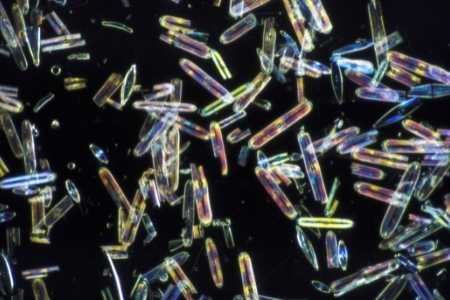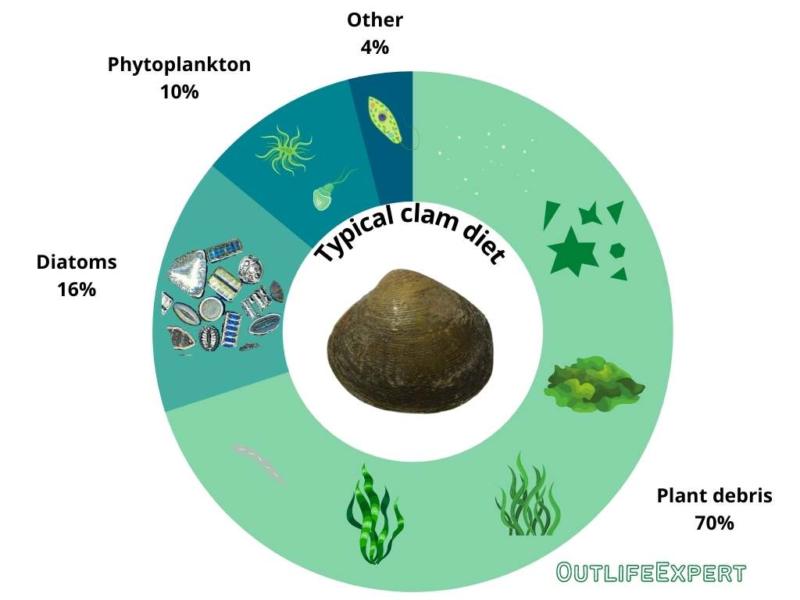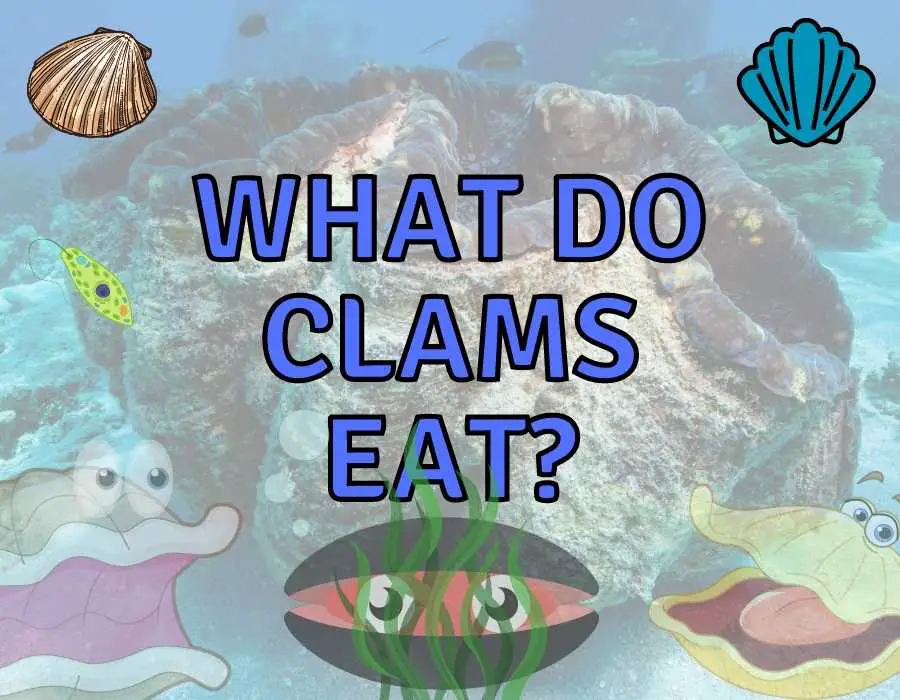Clams are a type of Mollusk that have two shells and a soft body. They can be found in oceans, shallow water, and even on the coast during the tide.
Clams eat microscopic organic particles floating in the water such as phytoplankton, zooplankton, algae, bacteria, and a variety of breakdown products from dead plants and animals. They do this by filtering the water through their gills.
It is also important to take note that even though clams are built similarly in terms of appearance and feeding mechanism, they still have differences in their diet depending on where they live and what species they belong to.
Here are some questions and answers regarding the sustenance of different clam types to help everyone interested in clam diets; including those owning a fish tank!
Contents
What do saltwater clams eat?
When saltwater clams are in their wild environments such as the ocean and sea, they generally feed on plankton and other organic particles.
Planktons are the little marine organisms, microscopic plants or animals, that are carried along with tides and act as a major food source for many marine animals like clams.
Other than planktons, saltwater clams also feed on other flowing microorganisms like bacteria, protists, and decomposing plant material.
Saltwater clams also feed on algae. Some algae, also known as zooxanthellae have a symbiotic relationship with larger clams such as the Giant Clam. Algae lives and thrives in the mantles of the clams while converting sunlight into beneficial nutrition that the clam takes up.
As the clam hosts the algae, the clam obtains food through the by-products of the algae’s photosynthesis.
That’s why giant clams can achieve gigantic sizes because of hosting many algae and feeding on the sugars and proteins generated by the algae living in their tissues.

Giant clams and razor clams are common saltwater clams that feed on phytoplankton, zooplankton (such as Euglena), and algae. The softshell clam also gets substantial nutrients from planktons. In addition to planktons, it also feeds on benthic diatoms and dissolved organic materials.
When placed in a saltwater tank, they won’t have as much access to these foods as they had in the ocean or sea. As a tank owner, the best food to give your clams would be frozen planktons, such as reef roids, or other sea creatures, which can be purchased at pet shops.
Blended seafood makes a convenient clam food option for you too. You can also opt to not feed your saltwater clams, but then you have to make sure that they have adequate lighting for algae to grow and that they are mature enough to handle less or zero feeding.
If you have or are thinking of getting clams for your saltwater or reef tank, take a look at this guide to feed clams in a saltwater tank.
What do clams eat in freshwater?
Freshwater and saltwater clams do not vary in their food. Their only major difference is their habitats. Freshwater clams thrive in water bodies that have minimal quantities of dissolved salts like lakes, ponds, and rivers.

When it comes to sustenance, freshwater clams feed on planktons as well. For instance, a famous freshwater clam, the Asiatic clam mostly feeds on plankton, whereas mud clams feed mostly on decaying plant material floating by.
Freshwater clams can also eat algae but they feed mostly on other tiny bits of floating edible matter in the water. Freshwater clams are relatively small and do not offer enough space to host algae as so they depend on floating food more. That includes decaying matters and debris.
When placed in a tank, freshwater clams make peaceful and friendly tank inhabitants. They also act as excellent helpers in removing and filtering debris from tank water.
While food is really not a big issue for clams due to their feeding anatomy, as caretakers it is still a good measure to get educated about their food to keep them at their optimum health and ensure longevity.
When it comes to feeding a freshwater clam in the aquarium, regular feeding may not be enough as they are constantly filter feeding. You’ll have to supply your clam’s diet with ground calcium tablets, fish flakes, or sinking algae wafers.
The freshwater clams will eventually filter feed them out. However, keep in mind to still feed them in moderation as overfeeding may lead to water issues.
How do clams eat?
Clams are called filter feeders because they eat through filtering their food. This process is called filter feeding. This type of feeding is seen in many marine animals, including blue whales and crabs.
Clams have no teeth that can help them to bite or chew their food, hence, they have to feed in a rather peculiar way to survive.
Clams have to open their mouths to obtain food. The water that contains clam foods like planktons, algae, and other organic materials passes through the incurrent siphon of the clam. This water then travels to and gets filtered by the clam gills.
The cilia in their gills allow them to trap the tiny food particles from the water. These tiny particles will then travel down to their mouth to be eaten. Then they are digested and converted into energy. Finally, the filtered water that traveled the gills will exit the clam mouth through the exhaling siphon.
How much and how fast do clams eat?
It greatly depends on the size of the clams, and how much water they filter per hour.
To calculate this, we need to have a few numbers in place. So let’s take two examples.
Where small freshwater clams being one to two inches long will filter through approximately 4 gallons of water per day, larger oysters (while strictly speaking not clams, they have been well studied so I will include the data for comparison) can filter around 50 gallons a day
The amount of solids in seawater is quite little and depends of course on the location, depths, temperature, etc.
A study on the organic content of seawater estimates an organic particle content of around 100g per m3, most of which is estimated to be the phytoplankton that clams eat.
That is, around 100g “clam food” per 264 gallons (1000L/3.78) of seawater.
So a smaller clam of around 1.5 inches in size filtering 4 gallons per day would be able to extract maximally (4/264)*100 = 1.5 grams (0.003 lbs) food from those 4 gallons of seawater.
In comparison, a larger oyster would be able to eat maximally (50/264)*100 = 19 grams (0.04 lbs) of organic matter from seawater in a day.
It should be noted that even the most efficient of filter feeders rarely utilize more than 80% of the digestible matter in the water, so these numbers are in the higher end.
Clam diets FAQs
People often have specific questions on the diet of clams. And while some are more relevant than others, I will do my best to go through and answer all of them below.
What do lake clams eat?
Lakes are generally freshwater environments so you will typically find freshwater clams here.
Lake clams are classified as freshwater clams and feed on planktons and filtered foods such as small organisms, decaying matters, and algae.
When placed in a water tank, remember to provide additional food such as sinking algae wafers and fish flakes.
What do clams eat in a pond?
A pond is a freshwater environment that relies on algae for sustenance. These algae don’t just serve as food for clams but also support the zooplankton and insects.
The zooplankton and insects are also then eaten by clams as well as other fishes and pond inhabitants. The pond clams’ filter-feeding through floating organic materials also helps maintain their nutrient level.
Unfortunately, pond clams like Giant Floaters may not be very ideal inhabitants in ponds. Overpopulated pond clams can over-filter the algae and clear the water, leaving lesser algae for other pond organisms and destroying the food chain.
What do baby clams eat?
Feeding baby clams doesn’t vary much with the large clams. The food is the same except for the frequency of feeding. Baby clams require daily sustenance as they still lack the ability to photosynthesize their own food.
Planktons like phytoplankton and zooplankton make excellent food for baby clams as they are high in nutrition crucial for clam development, the fatty acid content of plankton can also provide a source of sufficient energy for the baby clams.
What do coquina clams eat?
Coquina clams are clams that follow the waves of the water. They filter their foods through the movement of water making them often wave-washed into shores.
Their diet consists of suspended plant materials and organic residues.
Coquina clams are attractive to look at but they aren’t the best pet for your aquarium. Although they don’t pose any harm to other aquarium inhabitants, the lack of water movement can result in obtaining less food intake for them.
They utilize the water movements to feed so their chances of surviving in an enclosed space are relatively low.
What water plants do clams eat?
Clams may eat a variety of water plants, depending on what grows in their vicinity. They don’t eat the living plant though, as they can only filter out microscopic particles.
Clams generally eat the breakdown products of plants that float around in the water, so they could eat more distant plants if the current is strong.
Can clams eat seagrass?
Clams do not directly eat the seagrass, but they may eat the microscopic parts that fall off the plant, or the debris floating around from a dying plant nearby.
Do clams eat duckweed?
As for the other plants, clams do not directly eat duckweed, but they may eat the microscopic parts that fall off the plant, or the debris floating around from a dying plant nearby.
Do clams eat elodea?
Elodea is freshwater waterweed, that most aquarium owners will know for its ease of care.
Clams do not directly eat elodea, but they may eat the microscopic parts that fall off the plant, or the debris floating around from a dying plant nearby.
What do clams eat in a saltwater tank?
I have already written a separate article on this what to feed clams in saltwater tanks.
Do clams eat sea urchins?
No, there is no way a clam can attack and eat a sea urchin. It will, however, filter out and eat the debris floating from any dying animal nearby.
Do clams eat octopus?
No, there is no way a clam can attack and eat an octopus. It will, however, filter out and eat the debris floating from any dying animal nearby. But octopuses do indeed eat clams!
Do clams eat copepods?
Copepods are small crustaceans of around 1 mm in length, which is many times larger than the phytoplankton that clams primarily feed on that is usually around 20 times smaller!
It is important to understand that the gills of most clams cannot filter out and process larger animals like copepods, and if they could, their shell would not be digestible for the clam.
Do clams eat fish?
No, there is no way a clam can attack and eat fish. They will, however, filter out and eat the debris floating from any dying animal nearby.
Do clams eat bass?
No, there is no way a clam can attack and eat a bass. They will, however, filter out and eat the debris floating from any dying animal nearby.
Do clams eat bacteria?
Yes, bacteria are usually less than 1 micron in size, which is easily filtered by even the smallest of clams. In fact, the smallest clams and mussels live predominantly on a diet of bacteria in the ocean.
Do clams eat abalone?
The abalone is a type of snail larger than most clams. They cannot be ingested by clams unless they are dying and their particles are released into the water.
Do clams eat shrimp?
No, there is no way a clam can attack and eat a shrimp. They will, however, filter out and eat the debris floating from any dying animal nearby.
Do clams eat baby crabs?
It is impossible for a clam to eat a crab even smaller or baby crabs. They will, however, filter out and eat the debris floating from any dying crabs nearby.
However, crabs are fully capable of opening clams and even baby crabs gladly eat clams!
Do clams eat starfish?
No, there is no way a clam can attack and eat a starfish alive. They are only able to filter out and eat the debris floating from the dying animal if it is decaying nearby.
Do clams eat small fish?
No, there is no way a clam can attack and eat even smaller fish. They are only able to filter out and eat the debris floating from the dying animal if it is decaying nearby.
Do clams eat crabs?
No, there is no way a clam can attack and eat a crab alive. They are only able to filter out and eat the debris floating from the dying animal if it is decaying nearby.
However, crabs eat plenty of snails, clams, and mussels as mollusks are a major part of crabs diet.
Do clams eat worms?
No, clams are passive and they cannot catch or ingest worms.
How do clams eat and breathe?
Curiously enough, these two processes are tightly connected in clams. Clams eat and breathe through their gills. The gills function as a filter to absorb both nutrients and oxygen in clams.
Do clams eat krill?
No, krill are too big for clams to ingest. Some larger clams can eat smaller zooplankton though. They may also eat decaying krill.
What do clams eat in my aquarium?
Clams are typically kept in either freshwater or saltwater tanks. I have written a whole article about what clams eat in captivity here.
Do clams eat fish poop?
Definitely, they will eat all organic matter and bacteria present in the water.
Do clams eat minnows?
Nope, minnows are fish, and fish are too big for clams to eat. They are only able to filter out and eat the debris floating from the dying fish if it is decaying nearby.
Do clams eat mosquito larvae?
Clams are not likely to eat mosquito larvae, as they generally prefer food under the size of a micron – equalling the diameter of a human hair!
How long do clams eat?
Clams eat all the time unless they sense some sort of pollution of the water or are under attack, then they close their shells tightly together to avoid damage!
Do clams eat cornmeal?
Cornmeal may be a good way of feeding clams in captivity. They can filter out the tiny particles of corn-meal. However, they will need other sources of nutrients as well as cornmeal lacks essential amino acids and vitamins.
Conclusion
Clams are one of the most common mollusks on earth, with more than 3,000 different types. They are found in oceans all over the world where they play a crucial role in marine ecosystems.
A clam’s diet varies by species, but most eat whatever organic matter that floats by. That is, they mostly eat algae or other plant life while others dine on zooplankton. Regardless of their diet, clams are known for being filter feeders.
They strain water to catch food particles that float through it.
Without clams, the seven seas would be much dirtier and would have many more algae and rotting organic matter floating around that would use up oxygen.
Clams can also be eaten by humans and are a popular dish on many menus. Even though they’re pretty simple creatures, they can teach us a lot about how our own bodies work too.




